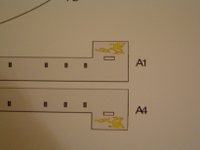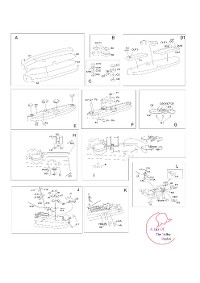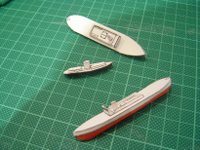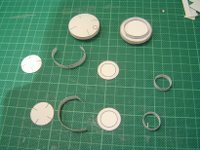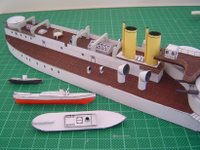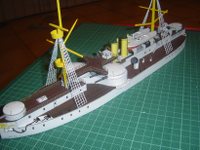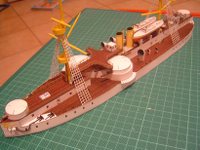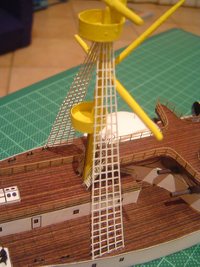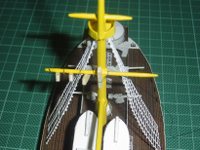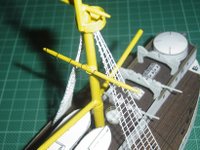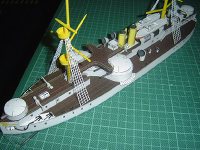I thought I would do a build of the free-download paper model of the Ting Yuen, a Chinese battleship of the 1880’s (http://homelf.kimo.com.tw/yukiyuji/TingYuen.zip).
A bit of history first:
”These were constructed in the German Vulcan yard and were patterned after and smaller versions of HMS Inflexible. Armed with four 12-inch guns in two turrets amidships and single 5.9-inch guns in smaller turrets at the bow and stern, they were powerful vessels. The central citadel had 14-inch armour plate although the turrets, in reality gun houses, had only one-inch of armour. When they arrived in China in 1886, they were the most powerful warships in the Far East. During the Sino-Japanese War of 1894, they were both present at the Battle of the Yalu with Ting Yuen being the flagship of Admiral Ting. Hit hundreds of times during the battle, the two Chinese Battleships fought off the main Japanese squadron. The 14-inch armour of their citadels proved impervious to Japanese fire. At the conclusion of the war in 1895 Ting Yuen was struck by a torpedo from a Japanese torpedo boat and beached as a total wreck. Chen Yuan was taken into the Japanese Navy and renamed Chin Yen.” (The Chinese Steam Navy 1862-1945 by Richard Wright).
The original is 1/700 scale PDF file, but in order to fit in with my first two ships (V108 and Uruguay Cruiser) and future plans of a 1/250 scale navy I had to enlarge them.
As I have adobe reader V 7 and Paint Shop Pro V8 I simply cut and pasted between these two programs and then printed out sections at 280% (from 1/700 to 1/250 scale) enlargement in order to fit on an A4 page.
Unfortunately this meant that the longest sections were cut between two pages and would have to be joined back together again at time of construction.
The construction report with pictures is at (I don't have website to host pictures):
http://kartonbau-aktiv.de/wbb2/thread.php?threadid=3784
Pic 1. Note A4 page in centre is original size of 1/700 other pages are how many required after scaling to 1/250.

Pic 2. Shows close up of main deck and two ? torpedo boats and parts.
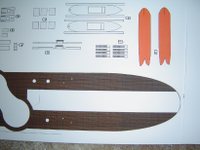
A bit of history first:
”These were constructed in the German Vulcan yard and were patterned after and smaller versions of HMS Inflexible. Armed with four 12-inch guns in two turrets amidships and single 5.9-inch guns in smaller turrets at the bow and stern, they were powerful vessels. The central citadel had 14-inch armour plate although the turrets, in reality gun houses, had only one-inch of armour. When they arrived in China in 1886, they were the most powerful warships in the Far East. During the Sino-Japanese War of 1894, they were both present at the Battle of the Yalu with Ting Yuen being the flagship of Admiral Ting. Hit hundreds of times during the battle, the two Chinese Battleships fought off the main Japanese squadron. The 14-inch armour of their citadels proved impervious to Japanese fire. At the conclusion of the war in 1895 Ting Yuen was struck by a torpedo from a Japanese torpedo boat and beached as a total wreck. Chen Yuan was taken into the Japanese Navy and renamed Chin Yen.” (The Chinese Steam Navy 1862-1945 by Richard Wright).
The original is 1/700 scale PDF file, but in order to fit in with my first two ships (V108 and Uruguay Cruiser) and future plans of a 1/250 scale navy I had to enlarge them.
As I have adobe reader V 7 and Paint Shop Pro V8 I simply cut and pasted between these two programs and then printed out sections at 280% (from 1/700 to 1/250 scale) enlargement in order to fit on an A4 page.
Unfortunately this meant that the longest sections were cut between two pages and would have to be joined back together again at time of construction.
The construction report with pictures is at (I don't have website to host pictures):
http://kartonbau-aktiv.de/wbb2/thread.php?threadid=3784
Pic 1. Note A4 page in centre is original size of 1/700 other pages are how many required after scaling to 1/250.

Pic 2. Shows close up of main deck and two ? torpedo boats and parts.



